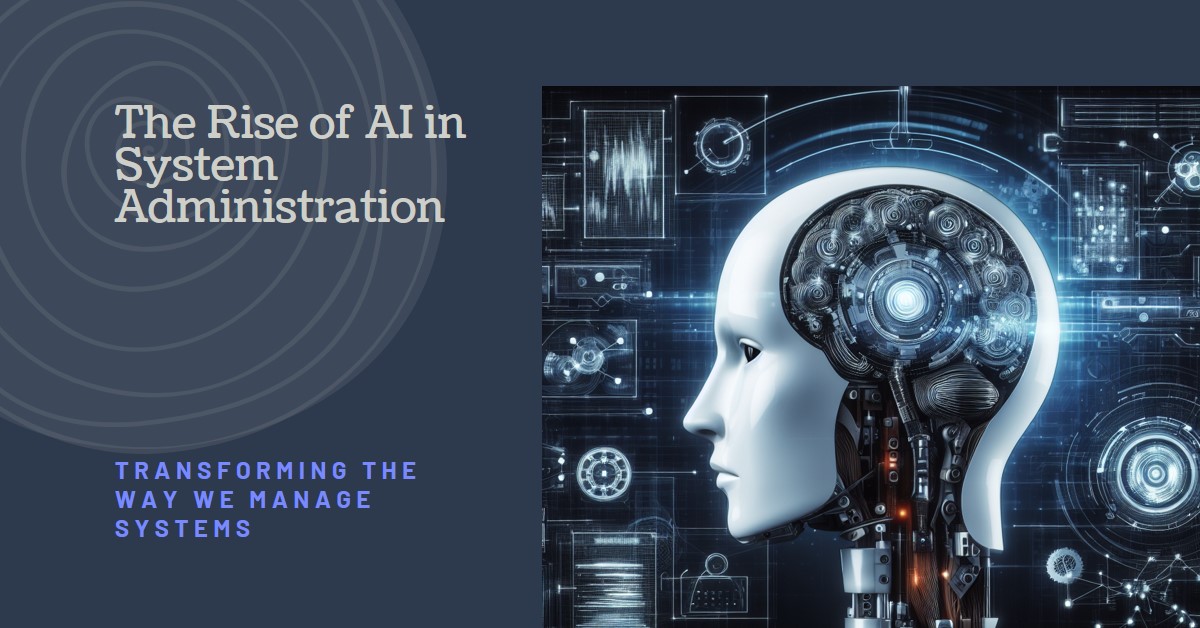In the ever-evolving landscape of technology, the integration of Artificial Intelligence (AI) has been a game-changer, especially in the realm of system administration. As organizations strive for greater efficiency, security, and agility in managing their IT infrastructure, AI is emerging as a powerful ally for system administrators. In this blog, we delve into the transformative impact of AI in system administration, exploring its benefits, challenges, and the future it promises.
The Rise of the Machines: How AI is Transforming System Administration
The Evolution of System Administration
Traditionally, system administration required meticulous manual intervention, with administrators juggling various tasks to ensure the smooth operation of IT systems. However, the rise of AI has ushered in a new era, automating routine tasks and allowing administrators to focus on strategic planning and problem-solving.
Benefits of AI in System Administration
1. Automation Redefined
AI’s role in system administration extends beyond basic automation. It involves intelligent decision-making, allowing systems to learn from past experiences, predict potential issues, and proactively address them. This shift from reactive to proactive automation ensures smoother operations and minimal downtime.
2. Predictive Analytics
Leveraging the power of AI, system administrators can now make data-driven decisions. Predictive analytics algorithms analyze historical data to foresee potential issues, enabling preemptive actions. This not only saves time but also ensures optimal system performance.
3. Security Enhancement
AI-driven tools play a crucial role in enhancing system security. From identifying and mitigating potential threats to recognizing unusual patterns in user behavior, AI contributes to fortifying the defenses of IT infrastructures.
4. Optimizing Resource Allocation
AI enables efficient resource management by dynamically allocating resources based on real-time demand. This ensures optimal utilization of computing power, storage, and network resources, leading to cost savings and improved performance.
Challenges and Considerations
- Integration Complexity: Implementing AI into existing systems can be complex, requiring careful planning and consideration of compatibility issues.
- Skill Set Requirements: System administrators may need to acquire new skills to effectively navigate and leverage AI tools, emphasizing the importance of continuous learning.
- Ethical Considerations: As AI systems become more autonomous, ethical concerns surrounding data privacy, bias, and accountability come to the forefront, necessitating ethical frameworks and guidelines.
The Human-AI Collaboration
One of the most fascinating aspects of AI in system administration is the collaborative relationship between human administrators and intelligent machines. AI augments human capabilities, providing insights, automating repetitive tasks, and offering data-driven recommendations. This collaboration empowers administrators to make more informed decisions and respond swiftly to evolving IT challenges.
Real-world Applications
The impact of AI on system administration goes beyond theoretical discussions, with tangible real-world applications showcasing its transformative potential.
Predictive Maintenance in Hardware Systems:
AI algorithms can predict when hardware components are likely to fail, enabling proactive maintenance and minimizing unplanned downtime. This predictive maintenance approach not only extends the lifespan of hardware but also contributes to significant cost savings.
Automated Patch Management:
AI-driven systems can automate the identification and application of software patches, ensuring that systems are up-to-date with the latest security fixes. This automated approach enhances system security by reducing the window of vulnerability to potential threats.
Self-healing Networks:
AI enables the creation of self-healing networks that can automatically detect and respond to network issues. This self-healing capability ensures continuous network availability, reducing the need for manual intervention and minimizing disruptions.
These real-world applications underscore the tangible and practical benefits that AI brings to system administration, proving its value in enhancing the resilience and reliability of IT infrastructure.
Overcoming Challenges Through Training and Education
Addressing the challenges posed by AI integration requires a proactive approach to training and education. Organizations must invest in upskilling their system administrators, fostering a culture of continuous learning. Training programs should encompass not only the technical aspects of AI but also the ethical considerations and responsible AI usage.
The collaboration between AI and human administrators is most effective when administrators are equipped with the knowledge and skills to navigate the complexities of AI integration. Upskilling initiatives contribute to a workforce that is not only proficient in leveraging AI tools but also conscious of ethical considerations, ensuring responsible and sustainable use of AI in system administration.
The Future Landscape
The synergy between human expertise and AI capabilities in system administration holds immense potential. The future promises further advancements, including more sophisticated AI algorithms, intuitive user interfaces, and increased collaboration between human administrators and AI systems.
More Sophisticated AI Algorithms:
As AI continues to evolve, we can expect more sophisticated algorithms that enhance the decision-making capabilities of AI systems. These advancements will enable AI to handle increasingly complex tasks, providing administrators with powerful tools to navigate the intricacies of modern IT environments.
Intuitive User Interfaces:
The future of AI in system administration will likely see the development of more intuitive user interfaces. These interfaces will simplify the interaction between administrators and AI systems, making it easier for non-technical users to harness the power of AI in managing IT infrastructure.
Increased Collaboration:
The collaboration between human administrators and AI systems will become more seamless. AI will not replace human administrators but will act as a force multiplier, amplifying their capabilities and allowing them to tackle more sophisticated challenges.
FAQs
Q1: How does AI impact system administration efficiency?
AI automates routine tasks, freeing up administrators to focus on strategic initiatives, ultimately enhancing overall efficiency.
Q2: What challenges may arise during the integration of AI in system administration?
Integrating AI may pose challenges such as complexity, compatibility issues, and the need for administrators to acquire new skill sets.
Q3: How does AI contribute to enhanced system security?
AI continuously monitors system data for potential security threats, offering real-time threat detection and response to safeguard against cyber threats.
Q4: What is the role of system administrators in an AI-driven environment?
While AI automates routine tasks, system administrators play a crucial role in strategic planning, problem-solving, and ensuring ethical and responsible AI use.
Q5: What is the role of system administrators in an AI-driven environment?
While AI automates routine tasks, system administrators play a crucial role in strategic planning, problem-solving, and ensuring ethical and responsible AI use.
Q6: How does AI impact system administration efficiency?
AI automates routine tasks, freeing up administrators to focus on strategic initiatives, ultimately enhancing overall efficiency.
In conclusion, the integration of AI in system administration is reshaping how organizations manage their IT infrastructure. Embracing this technological shift can lead to greater efficiency, improved security, and a more agile approach to IT management in the ever-evolving digital landscape.



